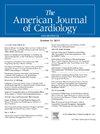使用改良的欧洲指南工具改进与先天性心脏病相关的肺动脉高压的风险预测。
IF 2.3
3区 医学
Q2 CARDIAC & CARDIOVASCULAR SYSTEMS
引用次数: 0
摘要
欧洲指南提倡以目标为导向的肺动脉高压(PAH)治疗方法,该方法以综合风险评估工具为基础,已在多个 PAH 亚组中得到验证。我们研究了它的鉴别能力,并探讨了三尖瓣环面收缩期偏移(TAPSE)和修订后的阈值,以提高其在成人先天性心脏病(CHD)人群中的预测能力。欧洲五个 PAH-CHD 专家中心共招募了 223 名成人(42±16 岁,66% 女性,68% 艾森曼格)。在基线访问和 4-18 个月的随访中,患者被分为 "低"、"中 "或 "高 "风险。根据一般 PAH 指南工具,风险组之间的存活率没有差异(P=n.s.),这主要是由于组别分布偏斜所致。使用 N 端脑钠肽 (NT-proBNP) 和 6 分钟步行距离 (6MWD) 的修订阈值(即 "低"、"中"、"高 "分别为 1400 ng/l 和 >400、165-400 和 20、16-20 和 16-20)对患者进行重新分类。本文章由计算机程序翻译,如有差异,请以英文原文为准。
Improved Risk Prediction Using a Refined European Guidelines Instrument in Pulmonary Arterial Hypertension Related to Congenital Heart Disease
The European guidelines advocate a goal-oriented treatment approach in pulmonary arterial hypertension (PAH), based on a comprehensive risk assessment instrument, which has been validated in several PAH subgroups. We investigated its discriminatory ability and explored tricuspid annular plane systolic excursion and revised thresholds to improve its predictability within the adult congenital heart disease (CHD) population.
In total, 223 adults (42 ± 16 years, 66% women, 68% Eisenmenger) were enrolled from 5 European PAH-CHD expert centers. Patients were classified as low, intermediate, or high risk at the baseline visit and at follow-up within 4 to 18 months. By the general PAH guidelines instrument, survival did not differ between the risk groups (p-value not significant), mostly because of the skewed group distribution. Reclassifying patients using revised thresholds for N-terminal pro–brain natriuretic peptide and 6-minute walk distance (i.e., low, intermediate, and high as <500, 500 to 1,400, >1,400 ng/L and >400, and 165 to 400 and <165 m, respectively) and use of tricuspid annular plane systolic excursion (low, intermediate, and high as >20, 16 to 20, and <16 mm, respectively) significantly improved the discrimination between the risk groups at baseline and follow-up (p = 0.001, receiver operating characteristic increase from 0.648 to 0.701), reclassifying 64 patients (29%). Irrespective of follow-up risk group, survival was better for patients with higher proportions of low-risk variables. Improvement to a low-risk profile at a median of 9 months of follow-up provided improved survival compared with the survival of patients who remained in the low-risk group.
In conclusion, the external validity of general risk instrument for PAH appeared to be of limited discriminatory value in patients with PAH-CHD. We propose a refined risk instrument with improved discrimination for PAH-CHD.
求助全文
通过发布文献求助,成功后即可免费获取论文全文。
去求助
来源期刊

American Journal of Cardiology
医学-心血管系统
CiteScore
4.00
自引率
3.60%
发文量
698
审稿时长
33 days
期刊介绍:
Published 24 times a year, The American Journal of Cardiology® is an independent journal designed for cardiovascular disease specialists and internists with a subspecialty in cardiology throughout the world. AJC is an independent, scientific, peer-reviewed journal of original articles that focus on the practical, clinical approach to the diagnosis and treatment of cardiovascular disease. AJC has one of the fastest acceptance to publication times in Cardiology. Features report on systemic hypertension, methodology, drugs, pacing, arrhythmia, preventive cardiology, congestive heart failure, valvular heart disease, congenital heart disease, and cardiomyopathy. Also included are editorials, readers'' comments, and symposia.
 求助内容:
求助内容: 应助结果提醒方式:
应助结果提醒方式:


